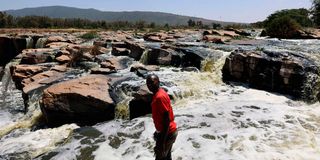Wangari Mathai prophesy fulfilled? Disaster looms as key rivers in Kenya dry up

Eric Ochieng a diver at Fourteen Falls Dam in Thika, he says the business is down after the once attraction site got polluted and water levels reduced.
Growing up in the South Rift Valley over three decades ago, Beatrice Cherono could not dare cross the Mara River or any of its tributaries; they violently sped towards Lake Victoria and would carry with them anything or anyone that dared to step into the water. During the rainy season, people living near the banks were forced to move to higher ground.
Fast-forward to February 2023 and Ms Cherono’s children can comfortably cross and at times even play on the riverbanks, thanks to drought.
Kenya is facing its worst drought in 40 years, and the disaster is taking with it the country’s major water sources. In their heydays, Kenya’s rivers were a magnificent force of nature that nurtured life. But the rivers are running dry, spreading misery and tension to millions of Kenyans whose fate now hangs in the balance.

Mariara River near Mukiria Technical Institute in Imenti Central.
Farms crucial to food security cannot be irrigated, fish that once fed thousands living along river banks are now gone, and water that sustained lives is now the source of conflict between communities.
The water scarcity has not spared wildlife either, with areas that were once green, teeming with all sorts of species border now dry and full of animal carcasses.
Yet the government is mulling lifting a ban on logging.
The Mara, Chemosit, Sisei, Kipsonoi, Itare, Nyangores, Amalo and Chepkulo rivers, which run through Narok, Kericho and Bomet counties, are among those inching closer to extinction.
Locals have linked the widespread planting of eucalyptus along riverbanks to the reduction of water. This has forced the Kenya Forest Service (KFS) to issue detailed guidelines on the handling of the trees, which are considered to contribute to land degradation by reducing groundwater levels.
In the sleepy Kabimoi trading centre in Baringo County, communities are now on the brink of going to war over the little that is left of the Emining river. Residents armed with bows and arrows stand guard over the dying river that once supplied water to several villages downstream. This has been the norm for close to a month now after an ambush by a group of youths from the neighbouring Mogotio sub-county. The Mogotio group, most of whom live in Emining area, claimed to be stopping illegal diversion of water upstream as they destroyed pumps, pipes and other infrastructure.
Eldama Ravine MP Musa Sirma and his Mogotio counterpart Reuben Kiborek have traded incitement and violence funding accusations.
In Emining, the local community has also armed some of its youth and designated them as protectors of the few water points left of the river.

Muro River in Elburgon, Nakuru County on February 25, 2023. Many rivers in the area have dried up.
“Last time when we went there and cleared the river we had water flowing for two days before it was then blocked,” Vincent Bor, a boda boda operator said.
For Mogotio residents, it is double tragedy as the alternative water source, the Molo river, is also drying up.
Still in Baringo, the scramble for water along the Perkerra river in Marigat, Baringo South has become the order of the day. Due to low water volumes in the river, locals are now fetching water from Lake Baringo. The water crisis has also affected thousands of farmers at the Perkerra Irrigation Scheme.
At Archer’s Post in Samburu County, random puddles of water and scattered rocks are all that is left of Ewaso Ng’iro river. A section of the river has been turned into a sand harvesting site.
“Sand harvesting on this part of the Ewaso Ng’iro has been a norm for years. The sand harvesting employs hundreds of youth from Samburu, Isiolo and the neighbourhood,” area resident John Lekupe said.
The river is a water source for over two million people in Nyandarua, Laikipia, Samburu, Isiolo and Wajir counties. Inter-community clashes have erupted at the border of Samburu and Isiolo where at least four persons have been killed in the past week.

Dry Ura River in Tharak North Sub County in Tharaka Nithi County. Alex Njeru | Nation Media Group
Environmental expert Prof Ratemo Michieka said the degradation taking place at the source of the river, the Aberdares, is to blame for the drying of the river. Hundreds of people have illegally settled on riparian land around lake Ol Bolossat, the source of River Ewaso Ng’iro. Various streams draining into the lake have been obstructed by farmers using gravity pipes, portable pumps and furrows. In Wanjohi area, for instance, hundreds of pipes divert water to private farms.
KFS commandant Alex Lemarkoko said there is an ongoing crackdown on people destroying the Aberdares.

A woman drives her livestock along a dry River Nyariginu in Laikipia County on February 16, 2023.
“We previously attempted to flush out some residents of Muruai, Kirima, Githima and Ol Bolossat but our hands were tied after they moved to court and obtained stay orders. Most of these people have title deeds, yet it is gazetted forest and riparian land,” said Mr Lemarkoko.
River Timau was a trusted source of water for residents of Muramati, Mugumo and Ndemu villages until last December. Recently, Mukogodo West MCA Nicholas Lempeira threatened to mobilise his constituents to invade private farms located on the foothills of Mt Kenya forest and destroy illegal water intakes and reservoirs.
In Nyamira and Kisii, the eucalyptus debate is also on. The two counties had a few years ago signed executive orders to have the eucalyptus trees removed from wetlands. The orders were never fully effected and appear to been forgotten as some farmers whose trees were cut have already replanted. Nyamira-based lawyer Wilfred Moseti has sued the government seeking to compel the government to give chiefs and KFS rangers power to protect wetlands.
In Eldoret, Sosian river is also receding and experts are concerned that it may soon be extinct. This has affected downstream towns like Bungoma, Webuye, Kitale, Eldoret and Kapenguria.
Nzoia river is a key source of water for Lake Victoria, and the degradation of its streams is posing a serious threat to its survival. Saiwa National Park, the home of the endangered rare sitatunga, has become collateral damage. John Mwavula said the clearing of the wetlands around the park has exposed wildlife to poachers, who have now killed at least 18 situtangas.

Prolonged drought in the country has seen reduced water levels in River Nzoia and River Yala.
Trans Nzoia County Executive Member for Environment and Water Patrick Gacheru said the passage of the county Climate Change Bill is a major boost to environmental conservation in the county. The Bill provides for the allocation of 2 per cent of the development budget towards climate mitigation measures.
In Siaya County, River Yala’s receding levels have seen the water company ration supply.
In Homa Bay County, the once mighty Rangwena river is also dying. Water levels in other rivers in the county, including Awach Tende, Awach Kibuon, Riana, Nyakwamba and Kuja, have also reduced.
In Kisumu County the government has resorted to treating water from Lake Victoria following reduced levels in rivers Nyando and Kibos. The neighbouring Vihiga is also suffering, as Ezava river’s levels recede. A water pan at Mulukhoro near Luanda town that has sustained hundreds of residents is now dry.
Members of 13 water resource users associations (WRUAs) in Meru County have sounded alarm that rivers are likely to dry up in the next few years. Although drought has been blamed, human activities are the major culprit, said Mr Patrick Mwirigi, the WRUAs chairman. Governor Kawira Mwangaza is yet to reconstitute the county’s environment management committee as the previous team’s mandate ended with the term of her predecessor Kiraitu Murungi.
In Tharaka-Nithi County, a spot check revealed that rivers Ura, Thangatha, Thanantu, Thingithu and Thuci are largely dry. In Nyeri the Ragati, Muthira, Sagana and Mwiyogo rivers are all running dry.

River Ontulili at Nanyuki-Timau road. Seven rivers along the 30km stretch have dried up.
In Thika, Athi River’s low volumes are choking the Fourteen Falls. The available water is already polluted with sewage dumped by local large-scale commercial farms.
John Mutua is among traders that have diversified into fishing, but he is not sure his business will last longer in case the rain fails.
In Kwale County, this is the fourth season that Winston Ndenge and over 3,000 other farmers will not be cultivating rice. Mr Ndege said Umba river, which is their source of water, has never dried up before.

An aerial view of the Ewaso Ng’iro river in Samburu County on February 14.
Vanga Rice Farmers chairperson Juma Mmwaganje said they have lost approximately Sh93 million yearly since 2018. Even rice farmers now depend on relief food.
Thiba river is one of the main sources of water for both Kirinyaga and Embu counties. But the river has largely dried up with residents of Mbeere South being the most affected. The little available water has been diverted into privately-owned farms upstream.
“Water from Thiba dam at the neighbouring Kirinyaga county can save the lives of my people, we are appealing to the national government to avail this water to us since it has not rained in the area for more than four seasons,” said area MCA Muriithi Kiura.





